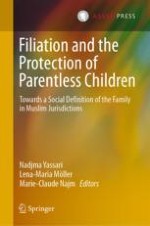2019 | OriginalPaper | Chapter
13. United Arab Emirates
Author : Lena-Maria Möller
Published in: Filiation and the Protection of Parentless Children
Publisher: T.M.C. Asser Press
Activate our intelligent search to find suitable subject content or patents.
Select sections of text to find matching patents with Artificial Intelligence. powered by
Select sections of text to find additional relevant content using AI-assisted search. powered by
